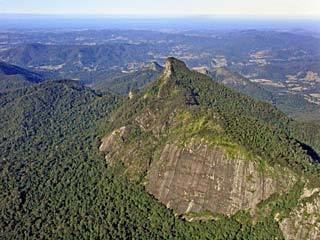Mountain type Volcanic plug Easiest route Walking track Prominence 952 m | Age of rock Over 23 million years Last eruption ~23 Ma Elevation 1,156 m | |
 | ||
Similar Springbrook - Queensland, Tweed Volcano, Mount Barney, Mount Beerwah, Mount Tibrogargan | ||
Mount Warning (Aboriginal: Wollumbin), a mountain in the Tweed Range in the Northern Rivers region of New South Wales, Australia, was formed from a volcanic plug of the now-gone Tweed Volcano. The mountain is located 14 kilometres (9 mi) west-south-west of Murwillumbah, near the border between New South Wales and Queensland. Lieutenant James Cook saw the mountain from the sea and named it Mount Warning.
Contents
- Map of Mount Warning NSW 2484 Australia
- Shield volcano
- Aboriginal significance
- Etymology
- Protected area
- Walking track
- References
Map of Mount Warning, NSW 2484, Australia
Shield volcano
Mount Warning is the central volcanic remnant of an ancient shield volcano, the Tweed Volcano, which would have been about 1,900 m (6,200 ft) above sea level or just under twice the height of the current mountain. This volcano erupted around 23 million years ago. As the mountain's central vent cooled it shrank, forming a depression at the top that has greatly eroded.
Today the vast areas that were part of the volcano include many mountains and ranges at some distance from Mount Warning, and include the Border Ranges, Tamborine Mountain, the McPherson Range and both the Lamington Plateau and Springbrook Plateaus. The erosion caldera formed since this eruption is easily visible around the summit and forms the rim of the Tweed Valley.
During the last stages of eruption, different and more resistant forms of lava that were cooler than those flows that created the shield volcano remained to form the current peak. The whole central Mount Warning massif was also pushed up by forces that remained active after lava eruptions had stopped.
Aboriginal significance
Wollumbin was removed as the name of the peak NNE of Mt Warning and applied as a dual name to Mt Warning by NSW Geographical names board in 2006. The mountain remains a place of cultural and traditional significance to the Bundjalung people and is the site of particular ceremonies and initiation rites. The Bundjalung observe cultural and traditional restrictions forbidding the uninitiated from climbing the mountain, and, as such, generally ask that others also do not attempt to climb the mountain. However, there are several websites that encourage climbers to hike the Mt. Warning/Wollumbin Trail up the mountain. The government National Parks and Wildlife Service advertise this request and do not encourage climbers, but it is not expressly forbidden by park regulations.
Etymology
On 16 May 1770, Lieutenant James Cook was the first European to record seeing "… a remarkable sharp peaked Mountain lying inland…" from a point of land he named Cape Byron. Just five hours later while sailing North, Cook was forced to change course to the East after encountering the dangerous reefs that run 3 miles to the East from Fingal Head, now named Danger Reefs (Inner, South, and Outer reefs).
The next morning, Cook recorded:
"…We now saw the breakers [reefs] again within us which we past at the distance of 1 League [5 km], they lay in the Lat de of 38°..8' [later changed to 28°..8'] & stretch off East two Leagues [10 km] from a point under which is a small Island. There situation may always be found by the peaked mountain before mentioned which bears SWBW from them this and on this account I have named Mount Warning it lies 7 or 8 Leagues [35-40 km] inland in the latitude of 28°..22" S° the land is high and hilly about it but it is conspicuous enough to be distinguished from everything else. The point off which these shoals lay I have named Point Danger to the northward of it the land which is low trends NWBN but we soon found that it did not keep that direction long before it turned again to the northward."
Protected area
The mountain is now protected by the surrounding Wollumbin National Park, and access is regulated by the New South Wales National Parks and Wildlife Service. Mount Warning is part of the United Nations World Heritage-listed Gondwana Rainforests of Australia.
Walking track
Over 60,000 people a year make the 8.8-kilometre (5.5 mi), five-hour round-trip trek to the top from Breakfast Creek.
An ascent of the mountain is discouraged out of respect for local Aboriginal lore, but if undertaken, takes approximately 1½ to 3½ hours (one way) and requires a good level of fitness. There are also viewing platforms at the summit. The total journey is 8.8 km (5.5 mi).
